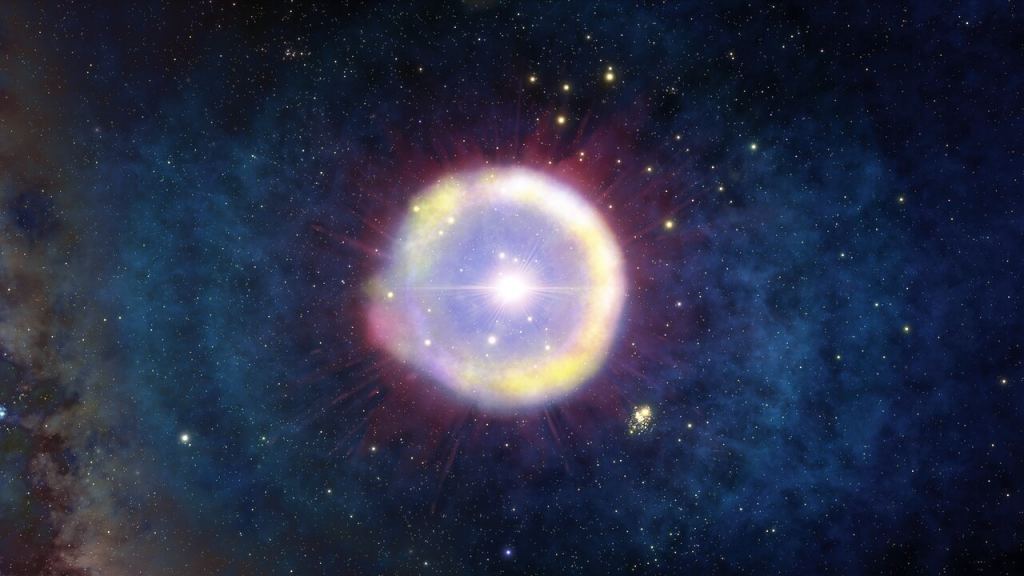According to the predominant cosmological model, the first stars in the Universe formed roughly 100,000 years after the Big Bang. Known as Population III stars, these early stellar masses were very large, short-lived, and contained virtually no metals or heavier elements. Over time, elements like carbon, nitrogen, oxygen, and iron formed in their interiors through nucleosynthesis.
When these stars reached the end of their lifespans, they exploded in a supernova many times greater than anything we see today (a “super-supernova”), causing these elements to be dispersed throughout the cosmos. For decades, astronomers have been attempting to find evidence of these earliest stars, yet all attempts to date have failed. But thanks to a recent study, a team led by the University of Tokyo thinks they may have finally spotted the first traces of one of the earliest stars in the Universe.
While analyzing data previously obtained by the Gemini North telescope of the most distant quasar ever observed, the team noticed a massive cloud of material around it. Based on their analysis, they believe the material came from a first-generation star after it went “super-supernova. ” The study, which recently appeared in The Astrophysical Journal, was led by Yuzuru Yoshii, a laureate professor of astronomy at the University of Tokyo and the Steward Observatory at the University of Arizona.
He was joined by researchers from the National Astronomical Observatory of Japan (NAOJ), Tokyo University’s Research Center for the Early Universe (RESCEU), the JINA Center for the Evolution of the Elements (JINA-CEE) at the University of Notre Dame, and the Australian National University’s Mount Stromlo Observatory. Population III stars are thought to have formed about 100,000 years after the Big Bang. Credit: ESA/Hubble, M.
Kornmesser. As they indicate in their study, the team believes the most likely explanation for what they observed is that the material is the remains of a first-generation star that exploded as a pair-instability supernova (aka. a “super-supernova”).
These happen when photons in the center of a star spontaneously turn into electrons and positrons – the antimatter counterpart to the electron – which reduces the radiation pressure inside the star, causing it to collapse. Much like how Population I and II stars collapse after exhausting their hydrogen and helium, this process caused Population III stars to go supernova. While such an event has never been witnessed, they are theorized to occur when gigantic stars (between 150 and 250 Solar masses) reach the end of their lives.
Unlike other supernovae, a pair-instability supernova leaves no stellar remnants and ejects all of the star’s matter into its surroundings. In addition, astronomers theorize that this material would contain over ten times more iron than magnesium compared to the ratio of these elements in our Sun. Because of their peculiar characteristics, there are only two ways to find evidence of Population III stars.
First, astronomers can attempt to observe a pair-instability supernova as it happens, the odds of which are very slim. Second, they can attempt to detect the material these stars eject into interstellar space by identifying its chemical signature. In this case, Yuzuru and his colleagues relied on the latter method, which consisted of consulting previous observations made with the Gemini Near-Infrared Spectrograph (GNIRS) on the 8.
1-meter Gemini North Telescope. This telescope is one of two (located in the northern and southern hemispheres) that make up the International Gemini Observatory, which is operated by the National Optical-Infrared Astronomy Research Laboratory (NOIRLab). To identify the quantities of each element present, the team employed an analytical method developed by Yuzuru and co-author Hiroaki Sameshima, a project research associate at the University of Tokyo’s Graduate School of Science.
This method involves measuring the intensity of wavelengths in the quasar’s spectrum, from which the chemical spectra of the material is extracted. Gemini North Observatory, located atop Maunakea, Hawaii. Credit: Gemini Observatory/AURA From their analysis, Yuzuru and his colleagues noted that ejected material contained over ten times more iron than magnesium compared to the ratio of these elements found in our Sun.
As Yuzuru explained in a NOIRLab press release: “It was obvious to me that the supernova candidate for this would be a pair-instability supernova of a Population III star, in which the entire star explodes without leaving any remnant behind. I was delighted and somewhat surprised to find that a pair-instability supernova of a star with a mass about 300 times that of the Sun provides a ratio of magnesium to iron that agrees with the low value we derived for the quasar. “ Similar searches have been conducted in the past, where astronomers looked for chemical evidence of Population III stars in the Milky Way.
And while one tentative identification was made in 2014, Yuzuru and his colleague believe these new results are the clearest indication of a pair-instability supernova to date. If their findings are confirmed, it will provide new insight into how our Universe has evolved since the first stars and galaxies formed. In the meantime, more observations are necessary to see if there are other objects out there that have similar characteristics.
Evidence of these stars could also be found within the Milky Way, where ejecta from primordial stars could be found among objects in our local Universe. With this latest study, astronomers now have a potential pathway for identifying the chemical signatures of the stars that played a vital role in the evolution of the cosmos, gave rise to the first planets, and even life itself. Further Reading: NOIR Lab, The Astrophysical Journal The post Astronomers see Tantalizing Evidence for one of the First Stars to Form in the Universe appeared first on Universe Today.
.
From: universetoday
URL: https://www.universetoday.com/157846/astronomers-see-tantalizing-evidence-for-one-of-the-first-stars-to-form-in-the-universe/



